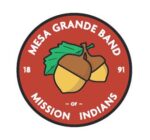Part 1: 1852 to 1905 Clans and Villages
In a 1918 article entitled “Clans and Moieties in Southern California”, ethnologist Edward Gifford identified 12 Northern Diegueno clans (or sibs) that historically inhabited San Diego County. Mesa Grande Band member Tomaso Curo (or Couro) was Gifford’s informant on the clans of the Northern Diegueno. Of the 12 clans, Curo identified four as being associated with Mesa Grande: Critcak, Kwilp, U’u, and Matuwir. The first three of these Mesa Grande clans lived at Pamo (or Pa’mu) during the winter and resided in and around villages on Mesa Grande in the summer. The fourth, Matuwir, was said to have once occupied the country for 8 miles to the south of Mesa Grande. Curo asserted that four different clans were associated with Santa Ysabel: Baipa, Esun, Gwaha, and Xipuwate. Another clan, Tumau, was scattered around the region; its members had settled at several villages, including Mesa Grande and Santa Ysabel. (Cited No. 9)
The mountain territory of Mesa Grande-Pamo clans included the villages of Tekemak (The main Mesa Grande village of Tract No. 2) and Kumehall/Camajal (or Mesa Chiquita and located between Tracts Nos. 1 and 2) (Cited No. 10) Though he did not identify the villages by their proper names, Deputy Surveyor H.S. Washburn noted the locations of three Indian Rancherias on or adjacent to Tracts Nos. 1 and 2 on his 1857 survey of the area. Two of the villages, Big La Mesa on Tract No. 2 and Little La Mesa located between Tract Nos. 1 and 2 on Section 35 of Township 11 South, Range 2 East, S.B.M., correspond to the villages of Mesa Grande and Mesa Chiquita. (Cited No. 11) Pamo, the winter home of the band, was about nine miles away in a stream valley. The difference in elevation between Pamo and Mesa Grande was substantial, and food supplies would have been minimal on the mesa during the winter months, thus explaining the winter migration downstream. (Cited No. 12)
The four Santa Ysabel clans hailed from the village Elkwanon/ElCuanan (or Santa Ysabel) and its adjacent Rancherias on the eastern end of the Santa Ysabel valley. In his 1871 survey of the Rancho Santa Ysabel, Deputy Surveyor M.G. Wheeler clearly noted the Indian village of Santa Ysabel and adjacent houses in the valley within Township 12 South, Range 3 East, S.B.M. (Cited No. 13)
The two bands, Mesa Grande and Santa Ysabel, resided in different stream drainages of the upper San Dieguito River and were about 15 miles away from each other. According to anthropologist Florence Shipek, who studied the Northern Diegueno extensively, the divide between stream drainages has historically been the boundary of band territory, and while the Santa Ysabel and Mesa Grande Bands held adjacent lands, they were separate bands. The exclusivity of the clans between the villages Mesa Grande-Pamo and Santa Ysabel and their different territorial boundaries indicated that these bands had different memberships and were distinct entities. (Cited No. 14)
Cited No. 10 – Florence Shipek, Pushed into the Rocks: Southern California Indian Land Tenure, 1769-1986, (Lincoln N.E. University of Nebraska Press 1988) p. 97 (MG-2393). The villages have a variety of spellings in the literature. For instance, in the 1852 Treaty of Santa Ysabel, the main Mesa Grande village is spelled To-co-mac and Mesa Chiquita is known as Ca-ma-jal. Shipek mistakenly located Kumehall (or Camajal) on the southern end of Tract No. 1. However, in his 1871 survey notes Myron Wheeler confirmed that Mesa Chiquita was between Tracts Nos. 1 and 2 (On Section 35, Township 11 South, Range 2 East S.B.M.) See: Myron G. Wheeler, Field Notes of the Final Survey or the Rancho Santa Ysabel, March 26th 1871, General Land Office, Sacramento CA page 16 (MG-2383). The links between members of Mesa Chiquita and Mesa Grande are explored later in this report and are described, in part, in the 1931 testimony of Thomas Couro/Curo. The Couro testimony also confirmed that Mesa Chiquita and Camajal were the same village. See testimony of Mr. Thomas Couro July 23rd 1931 (MG-0046).
Cited No. 12 – Edward W. Gifford, “Clans and Moieties in Southern California” p. 172 (MG-2270)
